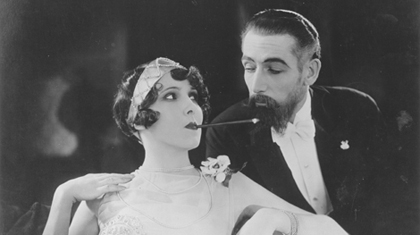Hitchcock, Hitchcock, Hitchcock, these days it’s all I ever blinking think about. Specifically silent Hitchcock, ahead of the feast that awaits us this summer. So today I’m kicking off a short introduction to the silent Hitchcocks, taking one film a week, so you’ll be fully up to speed by the time the screenings start in the summer.
As we’re starting on Friday 18 May, there’s just enough time for us to squeeze this first post into the marvellous For The Love of Film blogathon, a noble endeavour to raise funds to get the remaining reels of The White Shadow online, with a freshly composed score, streaming to cinephiles around the world. Here’s a little more explanation from the Self-Styled Siren:
This year, we are raising funds for the National Film Preservation Foundation’s project, The White Shadow, directed by Graham Cutts and written, assistant-directed, and just generally meddled with in a number of different ways by the one and only Alfred Hitchcock. The goal is to raise $15,000 to stream this once-lost, now-found, three-reel fragment online, free to all, and to record the score by Michael Mortilla. Marilyn Ferdinand, Rod Heath and the Siren are pleased to announce that we now have more than 100 bloggers signed up for this hoedown.
Do take a look at some of the posts in the blogathon, including Silent Volume’s elegant appraisal of Hitchcock’s Easy Virtue and some, er, poetry, from Shadowplay. If you like what you see, which you sure as heck will, please dip into your pocket for this good cause.
Now, to business. Each week we’ll be looking at a different silent Hitchcock – there’ll be a short introduction here, a juicy clip, and some carefully selected links. We’re starting with Hitch’s directorial debut, The Pleasure Garden.

This tale of backstage romance and farflung misdeeds may have been Hitchcock’s directorial debut, but he was so proud of it that he put his signature in the credits. “Actors come and actors go,” he told the Film Society, “but the name of the director should stay clearly in the mind of the audiences.” As for the “cattle”, American star Virginia Valli plays the heroine, Patsy, and Miles Mander the brute she is unfortunate enough to fall for. Another US star, Carmelita Geraghty, plays Patsy’s friend and ambitious fellow dancer, and her love interest arrives in the form of popular Scottish actor John Stuart.
The Pleasure Garden was filmed in Germany, but it has a very British feel, from the leery music-hall audiences to our leading ladies’ aspidistra-and-doily lodgings. It may not be a suspense thriller, but The Pleasure Garden opens in fine Hitchcockian style with pretty blonde showgirls (and their legs) being ogled on stage. It’s good old innocent fun to start with, of course, but unless it really is 1925 and this is the first Hitchcock film you’ve ever seen, you’ll sense a sinister frisson in such ardent voyeurism. And you’d be right to.

Like so many of Hitchcock’s silents, The Pleasure Garden was adapted for the screen by Eliot Stannard, a towering, if often unsung, figure in British silent cinema. While Hitchcock’s silents are undoubtedly less consistently surefooted than his blockbuster sound films (yer Psychos, yer Vertigos), they are all polished, sophisticated productions, deftly made by a team of film professionals. His debut benefits from the work of Stannard, Hitch’s wife Alma Reville, and producers Michael Balcon and Erich Pommer, nopt to mention its stars, including Valli, whom you may have seen elsewhere in King Vidor’s Wild Oranges (1924) and Mander whom you’ll surely know from his tour de force The First Born. But it’s Hitchcock’s show nonetheless: indeed, when the Spectator’s Iris Barry saw Hitchcock’s bravura debut, she sniffed out “new blood” for the British film industry immediately. This juvenilia is not so juvenile.
It must be said, however, that all reviews were not so enthusiastic. In the States, Variety spluttered: “A sappy chorus picture, probably intended for the sappy sticks where they still fall for this sort of a chorus girl story.” Fair comment, but Jill and Patsy themselves are hardly sappy, chorus girls or no.
Synopsis: “The diverging lives of two dancers from The Pleasure Garden nightspot. Jill rises to the heights and leaves her humble friend Patsy, and her fiancé, behind. Meanwhile, the good-natured Patsy stumbles into marriage with the selfish, dangerous Levet.” (From BFI Screenonline)
Hitchcock moment: Three minutes, 50 seconds into this clip, Jill gets her pocket picked by a couple of no-good hoods.
Watch out for: Patsy’s dog. There’s wisdom in those woofs.
Links worth clicking:
- BFI Screenonline
- Shadowplay is impressed by Mander’s lissome frame
- Michael Eaton on Eliot Stannard
- A witty critique by Strictly Vintage Hollywood
The Pleasure Garden screens at Wilton’s Music Hall on 28 & 29 June 2012 with a new score by Daniel Patrick Cohen. More information here.


Anyone cruising the Croisette of Cannes tomorrow afternoon (as you do… ), might be interested to know that I’m accompanying the premiere of the restoration of The Ring, in the Salle Bunuel at 17.30!
*squashes designer frock into suitcase, hops on plane* Have a great show!
Love the opening sequence! I was too slow to book for the Wilton’s Music Hall shows – maybe there’ll be some scouser touts outside selling “tick-hets”?